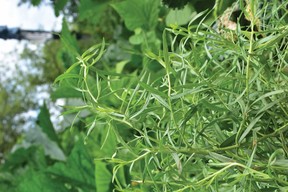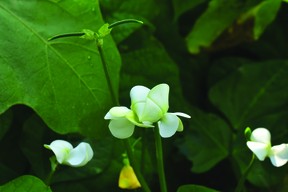Both the okra and cowpeas seed I planted this year were supplied by Ken and Martha Laing through the seed exchange that was part of the Ecological Farmers Association of Ontario conference last December

I enjoy trying new crops in my garden. Among the most recent are herbaceous tarragon and cowpeas, both introduced this spring.
Advertisement 2
Article content
Okra is another that I’ve planted over the past three years, but with limited success. This year, rather than squeezing it into my garden space, I’ve given it a great deal more room – as recommended. It should be planted no closer than 30 centimeters apart within rows and rows should be spaced at 60 centimeters or wider. The warm season plant can grow a meter or two in height, needs ample sunlight, and reputedly should keep producing until the first frost provided that the green fruits are harvested or removed soon after they appear.
Okra originates from East Africa, (or possibly West Africa) according to expert opinion. Cowpeas, also known as black-eyed peas, the poor man’s meat, is also from East Africa and is believed to be among the most ancient of cultivated crops. Tarragon, which now grows wild in North America, originates from Siberia and Mongolia; for flavoring purposes, only choose the “French” type.
Advertisement 3
Article content
I find it remarkable that garden plants originating from all points of the globe can exist, when properly managed, harmoniously within a small garden space. The potato, tomato, common bean and other species of Americas, next to Africa’s okra and cowpeas, and alongside those of the Mediterranean basin, Europe and Asia, onions, cabbage, leeks, beets, eggplant, cilantro and carrots.
Such is the way of the garden. The fruits and vegetables we grow are unaware of where they may have originated and they generally get along with the others, although it is advisable not to grow the same crop in the same location in your garden over consecutive years.
If only people could get along as well.
I picked up my tarragon plant from a local nursery this spring, and plopped it into a sunny location where it seems quite happy. Well-drained soils with a significant sand component are recommended and on heavier soils, try a raised bed. It is a perennial plant that may grow up to about a meter in height and, as a hardy perennial, it may die back in the winter in Southern Ontario but should reemerge in the spring.
Advertisement 4
Article content
Tarragon can be used fresh, dried, or infused into butter or vinegar. The green leaves have a licorice or anise-like flavor that pairs well with chicken, seafood and vegetables but use sparingly to avoid overpowering the dish.

It may also be a profitable choice for market gardeners. Earlier this year, having not tried the herb before, I purchased small amount, just a pinch really, that was priced at a few dollars.
In Canada, okra can be grown across the provinces but does best in warmer climates and in full sun. Plant only after all danger of frost is over. If direct seeding, air temperatures should be consistently above 16 degrees Celsius and preferably even warmer.
Pest and disease issues are not a large concern. It produces attractive blooms which after a few days develop into pods – the edible fruit. Depending on the variety, these grow to length of five to 12 centimeters; when the pods are ripped the stems will still be soft and easy to cut.
Advertisement 5
Article content
It is important, when the plants reach full production, to harvest the pods at least every other day. Otherwise, the plants will stop producing. To save seed, allow a few pods to mature later in the season; a couple pods contain enough seed for a small garden space.
Okra is a low-calorie food (unless fried in fat) with a strong nutritional profile and several health-related benefits. It can be fried, steamed, baked, sauteedeaten raw and used as a thickening agent in stews, notably the gumbos of the Southern United States and there is a myriad of recipes from the India subcontinent. On its own, okra is not particularly flavorful and therefore is typically used in combination with other ingredients.
The leaves, though somewhat less nutritious, are also edible.
Advertisement 6
Article content
Both the okra and cowpeas seed I planted this year were supplied by Ken and Martha Laing through the seed exchange that was part of the Ecological Farmers Association of Ontario conference last December. Ken Laing, in describing the cowpeas, said the crop was “interesting” which may suggest that there is potential for commercial production in the province.

Relatively small seeded, I planted it at the same time as green beans at a depth of about 12 millimeters and noticed it emerged a day or two sooner. There was some initial insect damage but by mid-July, despite the overabundance of rain, the crop was in full flower with some pods, located at the top of the plants, already formed.
Typically, dried cowpeas are soaked overnight prior to being cooked but in a garden setting, the immature pods, green peas and even the leaves can also be harvested for the table. They have an earthy, slightly nutty flavor and like okra, are typically combined with other ingredients.
Advertisement 7
Article content
Gardening provides the means to ‘eat the world’ while stepping lightly upon her. It is a universal concept, often embraced by small farmers and gardeners alike, regardless of which continent on which they happen to live.
However, in order to truly ‘step lightly’ knowing your way around the kitchen as well as the garden is essential, regardless of your particular dietary culture.
We have two shelves filled with cookbooks in our home of various cultural traditions, Indian, Chinese, Thai, Portuguese, Moroccan, etc. but my go-to volume is the 1951 version of Farmer’s iconic cookbook, the Boston Cooking-School Cook Book, originally published in 1896.
What I appreciate most about Farmer’s approach is her frugality. To get the most from your garden and kitchen, waste as little as possible, a time-honored tradition of all cultures, including those of North America.
Article content
